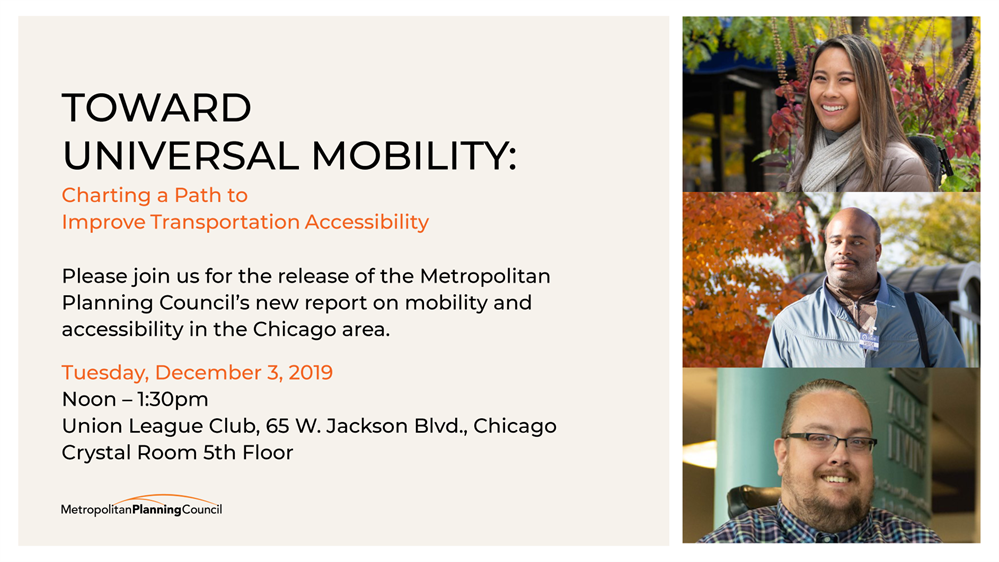A fragmented system of accessible transit services makes mobility challenging for the region's disabled and elderly population.

Image courtesy Lynn Renee Photography
At MPC, we take a lot of pride in the fact that our region has the second largest transit network in the country, and we never miss an opportunity to sing its praises. In 2018, we released Transit Means Business to make the business case for investing in transit, and we worked tirelessly in Springfield to help secure transit an impressive 22.5% of the 2019 Rebuild Illinois capital bill. This new revenue will help CTA, Metra and Pace purchase new vehicles, fix signals, and increase capacity. These investments will improve the lives of the region’s 1.6 million daily riders.
But what about the people who can’t ride traditional fixed-route transit due to age or disability? Most residents don’t realize that there’s an entire secondary network of mobility services that serve people with disabilities. These services are a lifeline for the people who rely on them, but due to funding constraints, local politics, and decades of inertia, they’re extremely fragmented. For MPC’s forthcoming report, Toward Universal Mobility, we took a closer look at three types of services to better understand the realities of traveling with a disability in the Chicago region.
ADA Paratransit
ADA Paratransit is a federally mandated complementary transit service that mirrors the fixed-route system of buses and rail. Service is provided within ¾ mile of CTA ‘L’ stations and within a ¾ mile buffer zone around bus routes. Rides are shared and must be booked 24 hours in advance. Hours of service mirror the adjacent fixed-route system, and no rides may be refused for eligible riders.
Pace On Demand
Pace operates 11 call-n-ride services throughout the region in areas where densities are too low to support regular fixed-route transit. The service is available to the general public, and reservations can be made as little as one hour in advance. Unlike ADA paratransit, rides can be refused if the individual service reaches capacity. Riders are also constrained to the relatively small geographic zones of each individual On Demand service.
Dial-a-Ride Services
There are dozens of Pace-affiliated Dial-a-Ride services throughout the region. These services are used to travel to places not accessible by ADA paratransit, and are generally available to older adults and people with disabilities. Each service is operated or supported to some degree by Pace in partnership with local jurisdictions at the county, township or municipal level. Frequently, there are local “sponsors” who provide matching funds for operation. These sponsors are usually social service agencies, hospitals or units of government. Because there’s a high degree of local control, there is a very wide range of service conditions. Services that operate right next to each other might have completely different rules on eligibility, trip purpose, hours of operation, pricing, and reservations.
A Fragmented System
While these services are incredibly important to the people who use them, the complex patchwork can make it very difficult to move around the region. Since service conditions can change when crossing arbitrary boundaries, planning a trip can be confusing and burdensome. As the following maps illustrate, the mobility landscape for a person with a disability radically changes depending on what day of the week it is, or even the time of day.
The map below shows how a very large number of services simply don’t run on the weekends. This is especially problematic for people who live outside the ADA paratransit service area. A lack of accessible transit on the weekends means that people with disabilities might miss out on social activities with family and friends. Errands or medical appointments must happen during the week as well, which makes it difficult to work.
According to the 2017 American Community Survey, about 13% of workers in the Chicago region commute via public transit. That number rises to 18% for people below 150% of the federal poverty level. For people without a personal vehicle, the rate skyrockets to 56%. We know that people with disabilities are both more likely to be poor and much more likely to have no access or ability to use a car. As a result, transit services play an incredibly important role in their ability to find and maintain employment. But as the map below shows, many services tailored to people with disabilities don’t run during peak morning commute times.
The trend above is even more pronounced for the evening commute. Many accessible transit services aren’t designed with regular employment in mind. It’s perhaps the biggest reason we see much higher part-time employment and unemployment rates among people with disabilities. It’s not that the desire or ability to work is missing, it’s that we haven’t invested in the supportive services needed to consistently and reliably connect people with additional mobility needs to the region’s jobs.
So what can we do about it?
MPC’s Toward Universal Mobility report proposes 32 recommendations that will help improve transportation accessibility for everyone. To improve mobility outcomes for people with disabilities, we need to focus on regional coordination to establish more consistent and cost-effective services across jurisdictions. We need to use technology to provide better information to riders and improve the customer experience. Lastly, we need to think about every part of the journey, from the first 100 feet of a trip, to the last 100 feet. We need to build out our region’s pedestrian infrastructure with a complete sidewalk network, safe crossings, and accessible signals.
To learn more about MPC's Toward Universal Mobility research findings and policy recommendations, register for the report release and roundtable discussion today!
